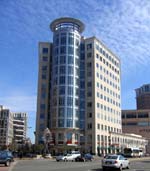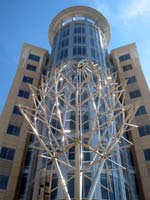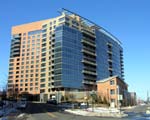
|
|
|
|
 |
|
Home Site Search Contact Us Subscribe
|
|
|
|
INSIGHT: Searching for Architectural Excellence and Ready to be Bold
Arlington County, Virginia, launches community discussions on the elements of great design. By Roberto Moranchel March 29, 2007 Can a suburban county located just across a river from the nation’s capital become the venue for exciting architecture? Arlington County thinks so, and it has sparked a public discussion of how to make that happen.
It’s an approach that has served Arlington well in the past – throw an idea out into the community – bring in outside experts to stimulate debate – then translate the concept into specific policies. The county did that in the 1990s, when it initiated a broad-based discussion about urban villages. Today, Arlington is nationally recognized as a model of New Urbanism, which emphasizes the creation of walkable, transit-oriented communities where the development of jobs and housing is balanced.
The County Board is hoping to duplicate that success in a push to achieve better architectural design of both public and private buildings in Arlington, a 26-square-mile community of 200,000 across the Potomac from Washington, DC.
“Because there are differing and sometimes subjective standards of what the County is looking for in design, we wind up getting plain vanilla, ‘safe’ buildings,” says County Board Chairman Paul Ferguson. Board members want to make clear, he explains, that “we want to see more distinctive architecture. We are ready to be bold.”
Anthony Fusarelli, an urban designer with the County, and I put together the Architecture Speakers Series, a program focusing on several important design issues that Arlington is now grappling with. The community discussion got underway in October 2006, with an exciting multi-media presentation by architect Enrique Norten, Hon. FAIA, founder and principal of New York City/Mexico City-based TEN Arquitectos.
Norten described Arlington’s master plan as “brilliant” in its mapping out the transition from an entirely suburban community to a transit-oriented, more urban county. If the vision is realized, the architect said the County “will create a place that is unique and special and different from all others.”
But after carefully reading the plan and viewing images of Arlington public and private buildings, Norten said he was concerned that the County’s careful planning is not reflected in the quality of design of its buildings. Arlington’s architecture “is worrisome – the images do not respond to such a great vision, and I hope that will change.”
The next program was a panel discussion, in January 2007 that explored how to balance the ever-increasing demand for secure structures with the desire to create buildings that are more than urban bunkers. Featured speaker Barbara A. Nadel, FAIA, the author of “Building Security: Handbook for Architectural Planning and Design,” set the tone of the discussion when she insisted that the pursuit of security does not require the sacrifice of great design.
“We can integrate security and design excellence to achieve a greater operational building,” Nadel said. Ed Feiner, FAIA, director of office operations for the Washington, DC, office of Skidmore, Owings & Merrill and former chief architect of the General Services Administration, added that there is a danger in going too far in the effort to secure buildings against any possible threat.
The question of how to balance security needs with a desire to encourage great design is an urgent one for Arlington, a county that faces the loss of some 15,000 defense-related jobs through the Pentagon’s Base Realignment and Closure (BRAC) process. The Pentagon has decided to move those jobs to more rural locations, where they believe it will be easier to build secure facilities.
“What I took away from the security and design discussion was: don’t overreact,” said County Board Member Jay Fisette, one of the initiators of the Architectural Speaker series. “Of course, we want to incorporate security in the design of buildings, but don’t overreact – because if we do, we could destroy the livability of our community.”
The ultimate goal is to find common ground for what constitutes quality architecture, how to create it, and then put in place the policies “to ensure that we get it as often as we can,” Fisette said.
The aim of the Architecture Speakers Series is to encourage developers, the County Board, the County planning staff, and the community to think about great design when planning both public and private buildings. “I think we’ve done a very good job overall” in creating urban villages, Fisette said. “One area that has been lacking is architectural design. Many people come to Arlington and rave about our planning and our smart growth development – yet they are unimpressed with the architectural quality of some of our buildings. I think it is time now to ratchet up and find ways to ensure that the quality of the architecture meets the needs and the demands of the community.”
The series continues on June 14, 2007, with a presentation on sustainable architecture – a core value in a community that gives developers incentives in the form of additional building rights to “build green.” The speakers will include architects Travis Price, AIA, author of “The Archaeology of Tomorrow: Architecture and the Spirit of Place,” and Susan C. Piedmont-Palladino, a curator at the National Building Museum and associate professor of Architecture at Virginia Tech’s Washington/Alexandria Architecture Consortium.
Roberto Moranchel is senior architect and urban designer with Arlington County. |
(click on pictures to enlarge)  (Leon Vignes/Arlington County Government) Arlington Gateway Office Building (WDG Architects, 2005) (Leon Vignes/Arlington County Government) Ballston Point Building (Davis Carter Scott, 2004) (Leon Vignes/Arlington County Government) Ballston Point Building public art: Bud/Blossom by Wendy M. Ross, 2003: the expansion and contraction of the stainless steel sculpture reflects nature's energy as well as that of the busy intersection at which the artwork stands. (Leon Vignes/Arlington County Government) The Odyssey (Shalom Baranes Associates, 2006) (Leon Vignes/Arlington County Government) Lofts 590 at Crystal Towers (SK&I Architectural Design Group, 2005) |
© 2007 ArchNewsNow.com